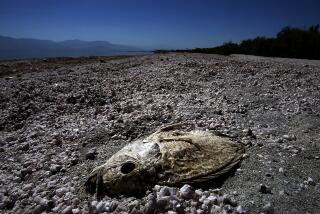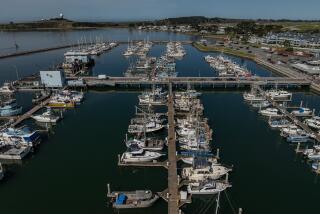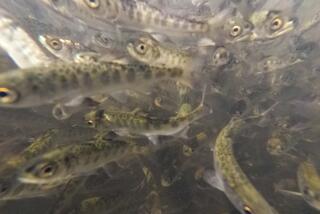Watermen of the Chesapeake Bay Face Their Biggest Test of Survival
- Share via
CRISFIELD, Md. — “How’s the crabbin’?” a sailor bellowed across the icy November sea to a waterman pulling crab pots. “Ain’t too many crabs now,” was the response in the singsong banter of the lower Eastern Shore. “What are you going to do?” the sailor pressed on.
“If there ain’t no crabs, there ain’t no oysters, and there ain’t no fish. It’s about time for me to get a real job. The problem is, I can’t do nothin’ else.”
Independent watermen, linked to the Chesapeake Bay by hundreds of years of ancestry, are going through their biggest test of survival. Faced with unprecedented death on the floor of the bay, they must stretch themselves to their limits tracking the life that remains.
That means working sun to sun in summer and autumn catching soft-shells and blue crabs, then hooking up a dredge and chasing the crabs from Maryland into Virginia in the blustery winter. It’s the crabs they are counting on since oysters, cherished since the days of the Roman Empire and once the backbone of the Chesapeake Bay seafood industry, have given out on them.
“Just being a brute doesn’t do it anymore. No waterman alive has ever seen the bay in the shape it’s in,” said Grant (Hon) Lawson, a seventh-generation waterman from Crisfield, the one-time oyster mecca of Maryland, which, in 1910, had the largest registry of sailing vessels of any port in America.
Peak in 1884
At the state industry’s peak in 1884, Maryland produced 15 million bushels of oysters. A century later, that figure hovers below 1 million bushels.
The parasite MSX, thriving in a bay that is highly saline from two years of drought, has killed off 90% of the oyster crop. The lower bay is virtually oysterless, and the beds in the upper bay are nearly raked clean by the heavy concentration of tongers--men armed with tools to scoop up their catch.
Disgruntled with the bay his family has fished since 1609, Lawson yanked up his last tongs and crab pots on Labor Day, 1986.
Although MSX does not kill other shellfish and fin fish, years of pollution have poisoned portions of most bay species save that crusty old crab, considered the “water buzzard” for its ability to live in filth.
The proud skipjack fleet that numbered more than 1,000 in its heyday, the last commercial fishing fleet under sail in the United States, is down to some 30 boats.
Slim Pickings
The Metompkin Bay Oyster Co. of Crisfield is getting a limited amount of oysters from around Cambridge and Tilghman Island, but the pickings are slim. In good Thanksgiving seasons, the company shucks six days a week. This November, it was down to three, maybe four days.
The oysters that remain are safe to eat and tasty--MSX hurts oysters, not people--yet, they are not as fleshy.
“The shell looks good, but the meat is not as fat,” said I.T. Todd, founder of the Metompkin firm, a packing house of oysters, soft crabs and crab meat. “Normally, this time of year, we will shuck about six pints of meat per bushel. This year, we’re shucking about four pints. And it’s not going to come back next year,” added Todd, a seafood packer for 40 years.
Todd’s eyes tear from a fresh blast of sweet crab steam wafting through his plant, which sits on the gateway to the Tangier Sound. “Even if we have a couple of normal rainfalls, it’s going to be four or five years before we have an oyster supply.”
It takes three years for oyster larvae to grow into 3-inch harvest size, and 1987-88 should have been a year of oyster bounty. “Two years ago, we had one of the best spat seasons (settling of newborn oysters), so we thought we’d have a good year now. Then MSX comes along and upsets everything,” said Larry Simms, president of the Maryland Waterman’s Assn.
High Salinity
“Should there be a good spat right now, they would all die anyway because the salinity is so high,” said Lawson, whose brother, Glenn, wrote a book on Hon, “The Last Waterman.”
Scientists believe that the oysters were more susceptible to MSX because they were already weakened by other wastes. Pollution has taken its toll on most species that used to flourish in the bay, a 200-mile-long estuary fed by toxic chemicals, sewage, farm runoff and excess nutrients from 50 major tributaries.
Officials in Maryland, Virginia, Pennsylvania and the District of Columbia are fighting back with a long-term regional pact, drafted in August and scheduled to be finalized in December. The plan calls for combined efforts to decrease wastes flowing into the bay by 40%.
This latest agreement marks the first milestone since 1983, when President Reagan committed his Administration to the cleanup of the bay in response to a massive Environmental Protection Agency study that found the bay to be a toilet of pollutants capable only of flushing out 1% of its contaminants. “Clearly an ecosystem in decline,” was the conclusion.
The new initiative would give the states and the District of Columbia until the year 2000 to reduce the nutrients going into the bay, primarily nitrogen and phosphorous that enter through sewage treatment plants and runoff from farmland. The nutrients fertilize thick algae that use up vital oxygen, choking the life out of other organisms that are the source of the bay food chain.
In late 1987, four years after the EPA study sparked headlines that screamed “The Chesapeake Bay is Dying,” the seafood-rich cradle romanced by James Michener in “Chesapeake” and William Warner in his 1977 Pulitzer Prize-winner “Beautiful Swimmers” has been impeded in its decline.
“The clamor of people for saving the bay has finally been heard and politicians are realizing that cleaning up the bay is what the people want,” said Will Baker, director for a decade of the Chesapeake Bay Foundation, a nonprofit conservation group in Annapolis that has been influential in prompting lawmakers to take action.
“Money is now being appropriated in million-dollar chunks,” said Baker, who sits on a monitoring panel for the National Science Foundation. He feels that if the level of commitment continues, real improvements will be visible in 10 years.
How about today? “If you want to force the question, ‘Is the bay getting cleaner or dirtier?’ I would say the rate of decline is slowing,” he said. “But, it’s really seat of the pants. It’s going to take a long time.”
------
Grant Corbin, a stocky waterman from Deal Island and a central figure in “Beautiful Swimmers,” thinks the bay would stand a better chance of survival if the true experts were running things instead of Ph.Ds and politicians.
“The watermen could do a whole lot better,” said Corbin.
“We’ve worked on the water our whole life. If a waterman’s 60, he’s been on the water close to 50 years. Now a man who’s gone to college, he’s learned something in a few years, but he’s read it out of a book. The waterman knows the water.”
Corbin, 40, has not oystered for two seasons, but he makes a good living crabbing nearly year-round. “With no oysters, there’s a lot more crabbers, and that’s the main thing that worries me,” said Corbin. “Crabbing isn’t going to stand up to more men putting in more pots. In time, we’re going to hurt the crab, too.”
State governments may be pumping millions into the bay long-term, but many watermen like Hon Lawson have been forced off the water and into something that pays. After 40 years of oystering and crabbing, Lawson opened the Crisfield Art Gallery, a showcase for bay artists.
‘Barometer of Health’
“The watermen have always been the barometer of the health of the bay,” said Don Baugh, education director for the Chesapeake Bay Foundation. “If the watermen are doing well, that means there are a lot of creatures out there living.
“Now, whole species have been wiped out. Shad was the No. 1 fish in the bay commercially. I haven’t seen one in years. Herring, rockfish are in dangerously low stocks, and there’s a ban on fishing them. Basically, every species of freshwater spawning fish, which would be most of the fish related to the bay--your rockfish, white perch, yellow perch, herring--is on a dramatic decline and we’re in danger of losing every one of them.”
Shifting careers is a painful choice for headstrong watermen who have known nothing else but being their own bosses and having only the pinch of angry crabs and the elements to contend with. A few will tell you their best years brought in close to $50,000--after expenses.
They start training for the trade as kids tagging along with their fathers and, upon high school graduation, they usually go into commercial fishing full time and stick with it until they die.
College used to be out of the question: A boy born to a waterman became a waterman, period. Not these days.
‘Didn’t See Future’
“I encouraged my son not to go into it, and he’s a good waterman,” Lawson said with a sigh. “I didn’t see a future there for him. I don’t believe the bay is going to get better in my lifetime.
“I mean, my father used to tong barehanded because he couldn’t get rubber gloves during World War II, then he’d put ice on his bloody hands,” added Lawson, whose face is burnished red and crossed with lines from decades of sun and wind.
“Those fellows were the old iron men in the ‘30s and ‘40s. Now, we work with insulated underwear and insulated gloves and insulated boots, but I’m 52 and I wasn’t making a living. Finally, I had to pull up my crab pots and say, ‘This is it.’ ”
Clarence Tyler of Smith Island has taken on carpentry and plumbing jobs instead of depending solely on commercial fishing like the Tyler men have done since the family settled the island in the 1600s. He sits on his docked Chesapeake work boat, the Knight Rider, smoking a cigarette and shucking a half-dozen oysters for a lunch of stew.
“ ‘Bout all you can catch now,” he said, swirling the lean-looking oysters in the bottom of a steel pot. Tyler “hustled a bit extra” crabbing this summer to fatten his finances for winter. He wants his two young boys to pursue other professions when they become men. “I’m hoping to be able to keep this fever away from them. I really am.
“Yeah, it’s too tough out there now, and it’s getting worse,” said Tyler, a sinewy man in his mid-30s. “Twenty years ago, we really didn’t worry no whole lot about next year’s oyster. It just seemed Mother Nature was taking her right action to keep us with plenty. And, I guess she came along to show us that we got to take better care of what she provides us with.”
------
Hon Lawson’s son-in-law, Lee Wilson, has relied on oysters as his “bread and butter” for 10 years. Since the season opened Oct. 1, Wilson has been leaving his wife, two toddlers and his home in Crisfield every Sunday night to spend the week tonging up the bay off Kent Island.
He, too, is bitterly discouraged, but, at the prime age of 34, cannot fathom the notion of leaving the work he loves. “A lot of the men have quit. They just can’t make it. They’re driving trucks, doing anything. But I’m staying on the water. When there’s no more oysters, I’m going crab dredging in Virginia. You don’t quit. You can’t quit,” said Wilson.
Wilson is getting the same $22 a bushel from seafood packers he got last year. “We can’t get more than that because the packers are saying, ‘We can’t sell them because people are scared to eat them,’ ” he said.
Jerry Harris, president of W.H. Harris Seafood, a packing house on the Kent Narrows in Grasonville, says consumer jitters are based on fantasy, not fact. He’s eating this season’s oysters, his family is eating them and so are his friends. They’re just fine, he promises.
“I don’t see anything wrong with them,” said Harris. “Nobody around here is scared to eat oysters and people shouldn’t be scared anywhere else.” His oyster sales are way down and, like other industry insiders, Harris does not predict a turnaround in the immediate future.
1,200 Sold a Week
“We should be selling 4,000 gallons of oysters a week and we’re only selling 1,200 a week,” he said. “I can remember back in 1964, I was working on the water and it was a bad oyster season, but at least we could find them in the Potomac River. Now, you don’t have any anywhere.”
Bill Ward, owner of All Seasons Seafood market and restaurant in Laurel, Del., says his problems do not stem from customers squeamish over MSX.
“It’s the prices that are turning them away,” said Ward. “I’m selling less than half as many oysters as I was selling last year. Last year, a dozen oysters on the half shell were $6. This year, I’m selling them for $9.50, and people just aren’t going to pay that.
“My business is off a good 25% to 30% over what it was last year. You can go out and buy filet mignon a lot cheaper than you can buy bay flounder, which is running somewhere between $6 to $8 a pound to the consumer.
“Something better happen, or we just can’t stay in business.”
Sons Going, Too
Despite the dismal forecast for the succulent silver pearl of the Chesapeake Bay, Dwight Evans of Smith Island says there is no way he will ever dock and take a job in an office. The Evans men have been on the water for three centuries. He is thinking this winter of going clamming--clams are the one shellfish in abundance this year. His sons, ages 21 and 19, are going, too.
Evans, 42, laughs softly when asked what keeps him in it.
“Have you ever been treasure hunting? Have you ever been on the beach looking for something valuable? Looking for money? It’s like that, you go down in the water. You never know what you will find. You may come up with a big day’s work. Or you may go in the hole. And you never know; there’s no guarantee. You’ve got to find it and catch it, and it’s just interesting.
“This morning when we were going out, it was dark, real dark,” he said, his voice hushed. “And the water was crystal clear; I mean you could see the phosphorous in the water glow like fluorescent. And I come across schools of fish swimming like lights going through the water. It’s something that people not on the water day in and day out will never see.”
More to Read
Sign up for Essential California
The most important California stories and recommendations in your inbox every morning.
You may occasionally receive promotional content from the Los Angeles Times.










